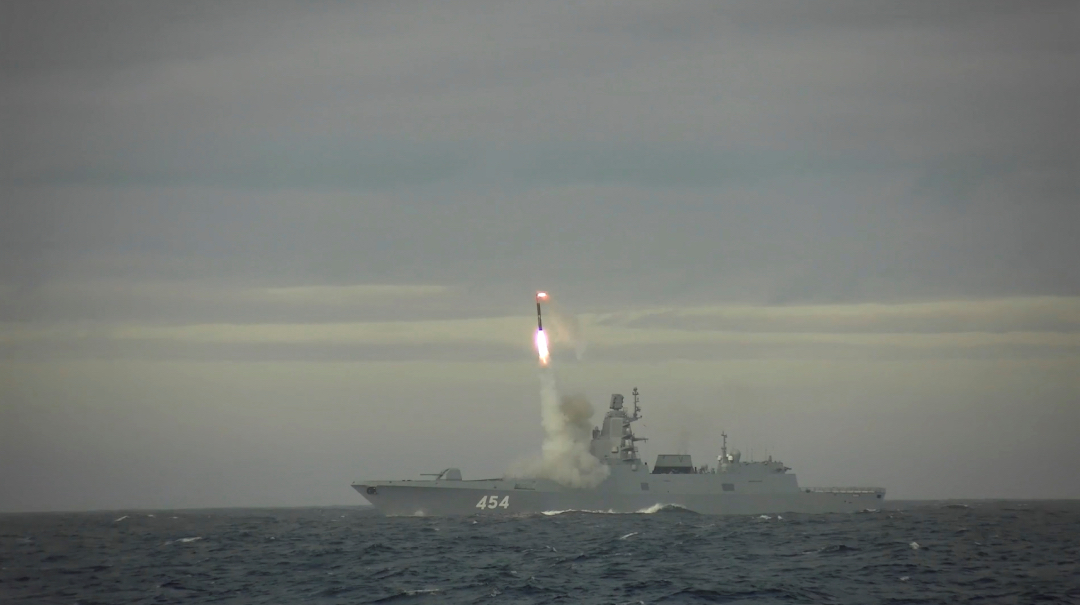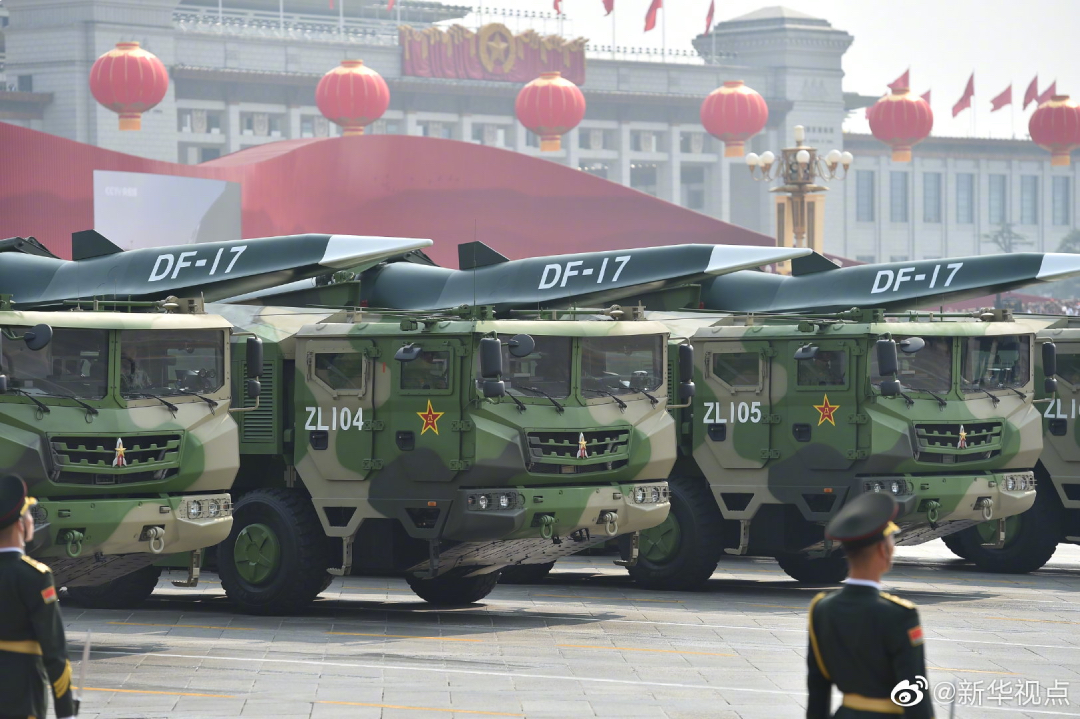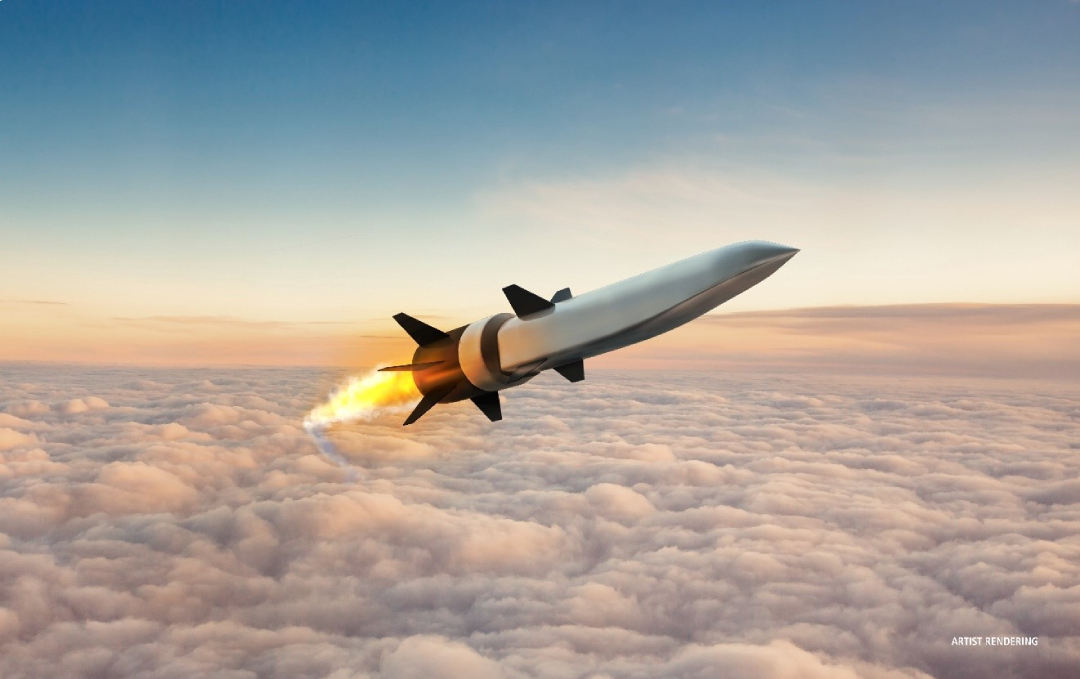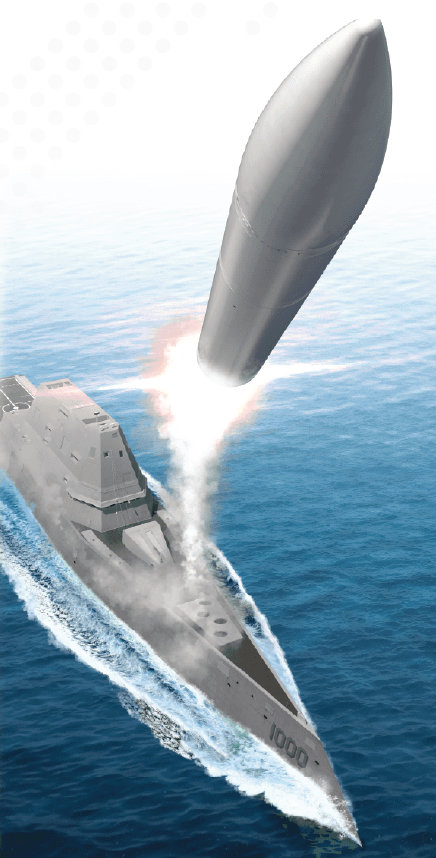
As peer-level adversaries develop and deploy hypersonic weapons while the United States and its allies look to match and counter those capabilities, a new frontier in strategic weapon systems is emerging.
Hypersonic weapons – typically glide vehicles deployed by ballistic missile or cruise missiles that exceed Mach 5 – have emerged as the latest technological domain for the world’s great military powers to contest, and for once the United States and its allies are coming from behind.
The sheer velocity at which hypersonic weapons travel is a significant challenge for the yet-to-be-developed systems that will need to counter them, while hypersonic glide vehicles (HGVs) deployed from space present a truly global strategic strike threat.
Moreover, the fact that hypersonic weapons could be nuclear armed presents an additional strategically destabilising factor in their use, given that, among the world’s nuclear powers, only China and India have overtly declared a nuclear ‘no first use’ policy.
Threats Deployed
The Russian Navy frigate Admiral Gorshkov, armed with Zircon hypersonic anti-ship missiles, became operational on 4 January 2023. As of late January the ship was conducting manoeuvres in the Atlantic, after which it was expected to join Chinese and South African vessels for drills in February off the coast of South Africa.
In May 2022 Russia test-fired a Zircon missile from Admiral Gorshkov in the Barents Sea to a target about 520 nautical miles (630 kilometres) away in the White Sea. The test was seen as an apparent warning to Sweden and Finland as they sought NATO membership in the wake of Russia’s February 2022 invasion of Ukraine.
The Zircon missile, which reportedly travels at Mach 9 (around 6,670 miles per hour /10,700 kilometres per hour), is not the first hypersonic/hyper-velocity weapon developed by Russia. The Avangard system, a long-range HGV deployed by intercontinental ballistic missile that has a claimed velocity of Mach 20-27 and the ability to perform evasive manoeuvres in flight, was reportedly tested from 2015 and, according to a March 2018 address by Russian President Vladimir Putin, had entered serial production by that point. Russian state news agency TASS reported on 27 December 2019 that the first missile regiment equipped with the Avangard system had become operational.

Back in 2018 Russian military sources stated that the Kinzhal hyper-velocity weapon system had entered service the previous year. This is not a newly developed hypersonic weapon per se – the Kinzhal system simply pairs a 9K720 Iskander ballistic missile with a MiG-31BM carrier aircraft – but the terminal velocity of the Iskander is around Mach 6-7. In March 2022 Russia announced that it had started launching Kinzhal systems against Ukraine, marking the first use of an air-launched hyper-velocity weapon in combat.
China, meanwhile, has been working on hypersonic weapons for decades, although Beijing’s progress in this fields appears to have taken the US defence intelligence community by surprise.
In a 1 October 2019 parade to celebrate the 70th anniversary of the People’s Republic of China, the People’s Liberation Army (PLA) unveiled a DF-17 medium-range ballistic missile mated to the DF-ZF HGV, which can reportedly reach speeds of Mach 5-10. The operational status of this weapon is unclear, although the HGV has been tested from 2014, the DF-17 was declared operational in 2019, and Chinese blogs presumably controlled by the PLA have referred to the DF-17/DF-ZF as a “combat ready hypersonic weapon”.

In August 2018 China announced a successful testing of what it called the Starry Sky -2 (Xingkong-2) hypersonic cruise missile, while in November 2018 the China Aerospace Science and Industry Corporation (CASIC) also unveiled the CM-401 short-range hypersonic anti-ship ballistic missile at Airshow China in Zhuhai. This system, which can be truck or ship launched according to the CASIC display at the show, is claimed by CASIC to have a velocity of Mach 4-6.
In October 2021 General Mark Milley, Chairman of the US Joint Chiefs of Staff, spoke in relation to a Chinese HGV test on 27 July of that year that reportedly conducted a low Earth orbit before cruising down towards its target. The general, who described the event to Bloomberg TV as “a very significant test of a hypersonic weapons system” and “very concerning”, noted on behalf of the US military that “it has all of our attention”.
North Korea also claimed to have conducted a number of successful HGV tests, most notably on 5 and 11 January 2022. The South Korean military confirmed that the 11 January test flew forCPS more than 378nm (700km) and reached Mach 10. Analysis of North Korean claims that the HGV manoeuvred during its glide phase at hypersonic speed has concluded that those claims are credible.
US Plays Catch Up
Several years ago, in a tacit acceptance even back then that the United States was behind the curve in hypersonics, the US fiscal year 2016 (FY16) National Defense Authentication Act section 804 Rapid Prototyping, Rapid Fielding programme expedited the swift development of the AGM-183A Air-Launched Rapid Response Weapon (ARRW).
After three initial failures in which the weapon was twice not released and on the third attempt did not fire its engine, the US Air Force (USAF) announced that on 14 May 2022 it had successfully released an ARRW. Another successful release demonstration followed on 12 July and then, on 9 December, a full prototype operational AGM-183A was successfully launched from a Boeing B-52H Stratofortress bomber of the coast of southern California.
The USAF stated on 4 December 2022 that the ARRW, which travels at Mach 5, “is scheduled to be operational as early as fall 2023”.
Meanwhile, back in April 2022 the United States, United Kingdom and Australia announced they had agreed to co-operate on the development of hypersonic weapons, defences against hypersonic weapons, as well as electronic warfare capabilities.
The US and Australian defence departments already have a joint hypersonic weapon programme called the Southern Cross Integrated Flight Research Experiment (SCIFiRE). Officially initiated in November 2020, the SCIFiRE programme is intended to produce an air-launched hypersonic cruise missile capable of travelling at Mach 5 that can be deployed by fighters such as the Boeing F/A-18E/F and Lockheed Martin F-35A as well as the Boeing P-8A Poseidon maritime patrol aircraft.
While the USAF awarded three 15-month SCIFiRE contracts to Boeing, Lockheed Martin, and Raytheon Technologies in June 2021 to complete preliminary designs of a hypersonic cruise missile, on 22 September 2022 the service announced that it had awarded Raytheon Missiles & Defense and Northrop Grumman a $985.35 million contract to develop and demonstrate Hypersonic Attack Cruise Missile (HACM) prototypes and “operationalise the Raytheon SCIFiRE prototype design for fighter aircraft integration”.

“We have over a decade of co-operation with our Australian allies in the advancement of hypersonic technologies, and now we will bring that shared knowledge to bear to address urgent national defence requirements,” Andrew Hunter, assistant secretary of the Air Force for acquisition, technology and logistics, was quoted as saying at the time.
The USAF stated that it plans to deliver an operational HACM capability by FY27.
In parallel with the HACM programme the US Defense Advanced Research Projects Agency (DARPA) and the USAF have been conducting a project known as the Hypersonic Air-breaching Weapon Concept (HAWC). This effort might now be redundant, since it was originally intended to be a technology pathfinder for the HACM, but three test flights have been conducted: the first, in September 2021, involved a demonstration vehicle built by Raytheon and Northrop Grumman; the second, in mid-March 2022, used a second vehicle design built by Lockheed Martin and Aerojet Rocketdyne; and the third, which again used the Raytheon/Northrop Grumman vehicle, was announced by DARPA on 18 July 2022 and took place earlier that month. In a press release DARPA stated of the most recent test, “After release from an aircraft, the first stage boosted the vehicle to the expected scramjet ignition envelope. From there the missile’s Northrop Grumman scramjet engine fired up and propelled the cruiser to speeds greater than Mach 5 for more than 300 nautical miles and reaching altitudes higher than 60,000 feet.”
This test, according to Andrew Knoedler, DARPA’s programme manager for HAWC, “allowed exploration of more of the flight and scramjet engine operating envelopes”, adding that “the navy and air force will have access to the data we’ve collected as they make development decisions for future high-speed weapons”.
Regarding surface-launched weapons, the US Army and US Navy have been progressing their own hypersonic weapon programmes. Previously these were separate efforts, but in 2018 the Pentagon directed the services to work in conjunction with each other.
For the army, Long-Range Precision Fires (LPRF) – including a hypersonic weapon capability – have been a top modernisation priority since the service released its Directive 2017-33 in November 2017 and the most urgent of those priorities for the last couple of years. Within the LRPF initiatives the Long-Range Hypersonic Weapon (LRHW) is likely to prove the most transformational weapon capability. The missile component of the LRHW, which will reportedly have a range of around 1,500nm (2,778km) and will also be common to the navy’s Conventional Prompt Strike (CPS) System, comprises the Common Hypersonic Glide Body (C-HGB) and a two-stage booster rocket provided by the navy. While the missile component of the LRHW is being developed by Lockheed Martin and Northrop Grumman, the C-HGB is reportedly based on the Alternate Re-Entry System developed by the army and Sandia National Laboratories, with Leidos subsidiary Dynetics under contract to produce the C-HGB prototypes.
Although the US Army had planned to field the LRHW in FY23, the weapon’s recent flight tests have not been successful. On 21 October 2021 the booster rocket failed, giving the C-HGB no chance to deploy, while in June 2022 a test of the entire LRHW missile component known as Joint Flight Campaign 1 (JFC1) also failed. Speaking at the Association of the US Army conference in Washington, DC, in early October 2022 the army’s director of hypersonics, directed energy, space and rapid acquisition, Lieutenant General Robert Rasch, acknowledged that the rapid pace of the LRHW/CPS programme was producing increased risk. While conceding that two further upcoming flight tests, JFC2 and JFC3, could also produce anomalies, the general maintained that the army was sticking to its plan to field the LRHW by late 2023. JFC2 and JFC3 are thus expected this year, although a US Army spokesperson told Armada in January that “test dates and event details are not announced in advance”.

The US Navy is similarly anticipating a deployment of the weapon, firstly on its three Zumwalt-class guided missile destroyers and then on its Virginia-class nuclear-powered attack submarines. On 6 January this year the Pentagon announced it had awarded Ingalls Shipbuilding a $10.5 million contract to plan for the integration of hypersonic missiles into USS Zumwalt (DDG-1000) and USS Michael Monsoor (DDG-1001), with USNI News reporting in November that the navy plans for the first Zumwalt-class destroyer to be ready to test a hypersonic missile in 2025. The first Virginia-class boat is expected to deploy with a hypersonic weapon payload by 2029, according to USNI News reporting.

Countering the Threat
For the United States and its allies the hypersonic overmatch currently wielded by the West’s greatest strategic rivals presents a clear threat to both to allied nations and to forward-deployed Western forces and military actions around the globe. While developing some degree of parity in offensive hypersonic weapon capabilities can deter a potential adversary from using its own hypersonic arsenal, developing air defences to negate or at least offset the threat posed by hypersonic weapons is also a strategic imperative.
‘Complex Air Defense: Countering the Hypersonic Missile Threat’, a report published by US thinktank the Center for Strategic and International Studies (CSIS) in February 2022, opens with the assertion that “Defending against hypersonic missiles is strategically necessary, technologically possible, and fiscally affordable, but it will not be easy.”
The report notes that the difficulty in defending against cruise missiles stems from the fact that they “combine the speed and range of ballistic missiles with the low-altitude and manoeuvrable flight profile of a cruise missile”.
The US Biden administration’s 2022 Missile Defense Review, an unclassified version of which was released on 27 October 2022, included a focus on ‘cruise missile defence for the homeland (CMD-H)’. Acknowledging that US missile defences need to move beyond the ability to counter ballistic missile threats from rogue states, the review stated, “To deter attempts by adversaries to stay under the nuclear threshold and achieve strategic results with conventional capabilities, the United States will examine active and passive defence measures to decrease the risk from any cruise missile strike against critical assets, regardless of origin.”
The US Ballistic Missile Defense System will thus need to become an overarching missile defence system. Defending against a threat spectrum that now includes hypersonic weapons will require rapid advances in every aspect of air defence capability, covering sensors, interceptors, command and control, system architecture, and doctrine.
To counter hypersonic weapons, much of the work being done by Raytheon Technologies is focusing on so called ‘left of launch’ solutions to defeat a hypersonic attack is before it happens using electronic warfare and directed-energy systems to jam and disable threat systems. Raytheon is also working on space-based technologies – including optical and infrared sensors, command and control systems, ground mission management systems and complex advanced missile detection and tracking algorithms – to detect, track and intercept hypersonic weapons in all phases of flight.
In June 2022 the US Missile Defense Agency awarded Northrop Grumman and Raytheon each USD41.5 million contracts to further develop and refine their concepts for a Glide Phase Interceptor (GPI) prototype. On 20 September 2022 Raytheon announced it had successfully completed the Systems Requirements Review – Prototype (SRR-P) for its GPI. The company will now move on with preliminary design of the system.
by Peter Felstead












